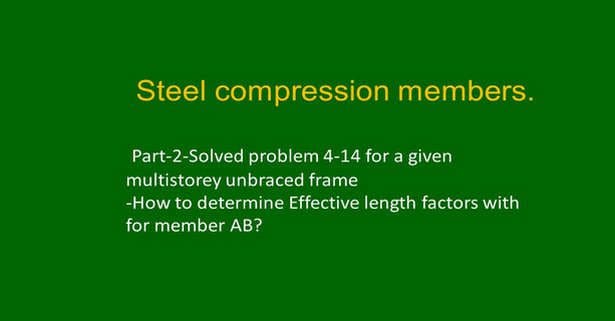Last Updated on July 29, 2024 by Maged kamel
Solved problem 4-14 part 2 for the effective length factor.
LRFD part for the effective length factor column AB.
Estimate GA value for joint A of the column.
For column AB, where A is at the top and b joint is at the bottom is a W10x33, from the Excel sheet, we get the property of the column as the gross area Ag=9.71 inch2, the moment of inertia about the major axis Ix=171.0 inch4, and the radius of gyration about the x=axis, rx=4.19 inch2. At joint A, we have two beams framing joint A with different span lengths, each having W12x14, the gross area Ag=4.16 inch2, Ix=88.60 inch4, and rx=4.62 inch2.
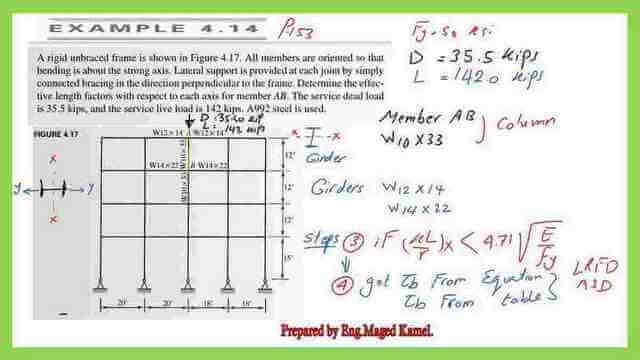
The length of the first beam is L=18′ and the second beam is L=20′. The height of column AB=12 feet, considering E is elastic for the column and beams, beams are always considered elastic.
GA value equals ∑EI/L for column AB /∑EI/L for the two framing beams. The terms E for column and E for beams will cancel each other, the numerator =Ix/L for column equals (171/12)=14.25.
The denominator equals ∑EI/L for beams, which will be the sum of two items, the first item equals (I/L) for beam1, which has a length of 18 ft, while the second beam has a length of 20 ft.
the two beams have an inertia of 88.60 inch4. The sum is (88.60/20+88.6/18) = (9.3522).
The GA value equals 14.25/9.3522=1.523. please refer to the next slider image for more details.
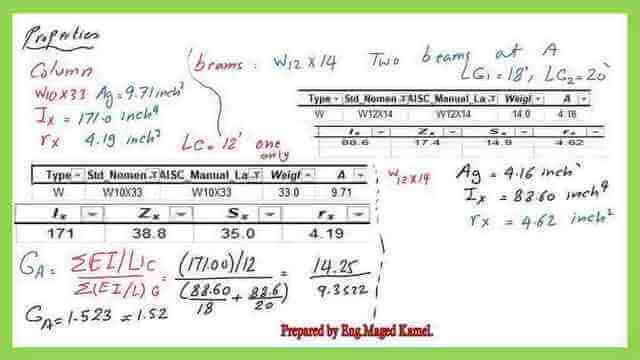
Estimate GB value for joint B of the column.
At joint B, two columns will be considered for each column section is W10x33 we have two beams with section W14x 22 for each we estimated the area of the beam section as, Ag =6.49 inch2, Ix=199 inch4,rx=5.54 inch2, and the inertia of the column is < inertia of the two beams.
Gb value equals 2∑EI/L for column AB /∑EI/L for the two framing beams. The terms E for column and E for beams will cancel each other, the numerator =Ix/L for column equals 2(171/12)=28.50.
The denominator equals ∑EI/L for beams, which will be the sum of two items, the first item equals (I/L) for beam1, which has a length of 18 ft, while the second beam has a length of 20 ft.
the two beams have an inertia of 99.0 inch4. The sum is (99/20+99/18) = (21.005).

Use the alignment chart to get the K value for column AB.
Since we have unbraced frames, we can use the unbraced frame graph to get the K factor using the estimated GA and GB we can find that the effective length k value as equals 1.45.
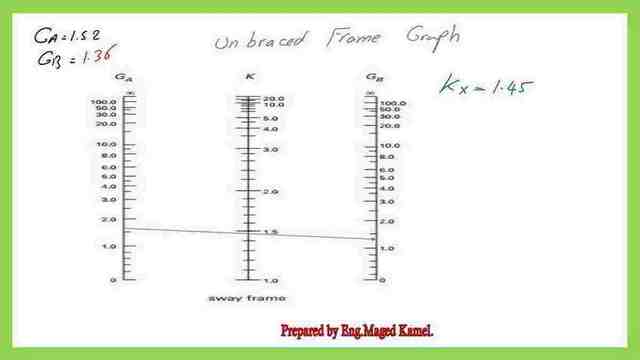
To use the French equation, then k= SQRT(1.60GAGb+4(GA+GB)+7.50)/SQRT(GA+GB+7.50), we make a substitution for the different values, and we get k=1.466.

Having estimated The k value check that K*L/r is smaller or bigger than 4.71*Sqrt(E/Fy). We proceed, having k=1.45, then KL/r at x=1.45(1212)/rx of the column which=4.19 inch2, KL/r at x=49.83 . for 4.71*(29000/50)=113.34. Kl/rx is less than 4.71*Sqqrt(E/Fy) , and the column is not long and is inelastic we need to estimate the value of stiffness reduction factor τb.
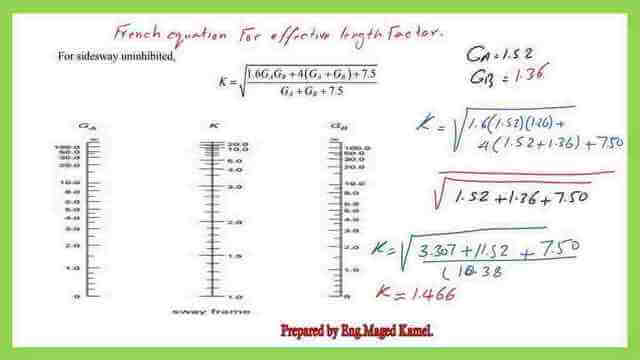
LRFD design procedure for τb.
For the LRFD design we start estimating P ultimate as 1.20 D+1.60L, D=35.50 kips, and L=142.0 kips, 1.2D+1.60L=1.235.5+1.6142= 269.80 kips. this value is considered as Pr for the equation of the reduction factor.
First, check that αPr/Pns <=0.50, then we will have τb=1, if not the τb will be <1.0. For the case of LRFD, Pr=Pult=269.80 kips. the yielding load Py=AgFy=9.7150=485.50 kips, αPr/Pns will be=(1269.80/485.50) =0.557 >0.50, then τb<1, but if
αPr/Pns<0.50, then τb=1. But in our case τb<1, then use this equation τb= 4(αPr/Pns)*(1-(αPr/Pns)).

We substitute the values as τb= 41269.80/485.50)(1-(1269.80/485.50)), τb=0.9865. This is the reduction stress factor. Prof. Segui has estimated the value as=0.9877.
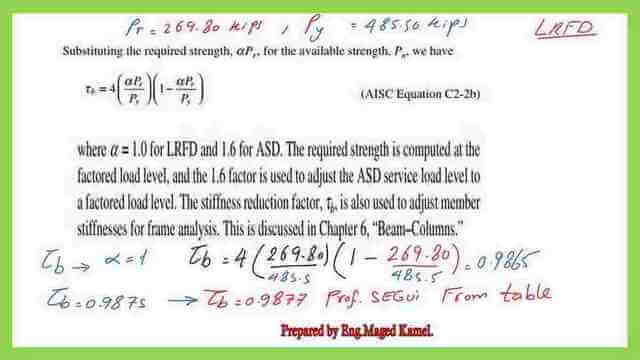
Use Table 4-13 to get τb -LRFD design.
We have Pu/A=269.80/9.70=27.79 we move with this value from the horizontal direction and intersect with the column for Fy=50 ksi. The stiffness factor is equal to 0.9877.
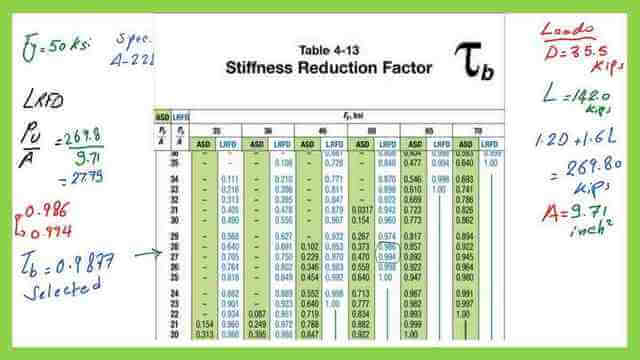
We need to adjust the k value, this is done by re-adjustment of GA, Gb, by multiplying by τb. The adjusted value of Ga=1.52*0.9877=1.5013, while the adjusted value of Gb=1.36*0.9877=1.3432.28 for the Solved problem 4-14 part 2 for effective length factor.
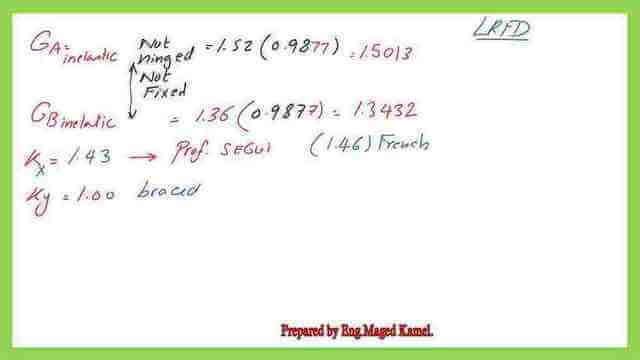
The final Kx value is found to be equal to 1.43 while Ky=1.0.
ASD design procedure for τb.
for the ASD design, we will estimate kA and Kb for column AB, the same procedure as we have estimated earlier will be repeated, check whether the column is elastic or inelastic for Kl/rx>= 4.71*Sqrt(E/Fy). Based on the estimation we will find the column is inelastic we need to find τb.
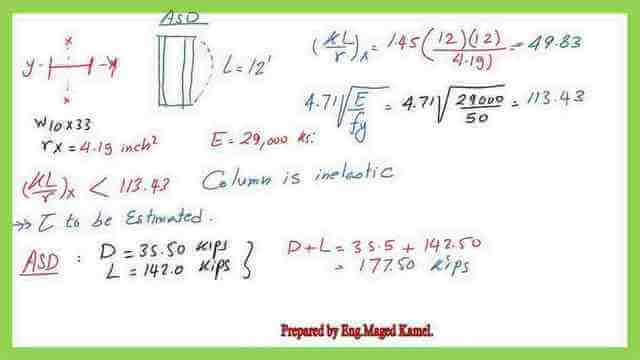
In the ASD calculation, we have D=35.50 kips and L=142.0 kips. Pt= 35.50+142.0=177.50 kips, we check if αPr/Pns<0.50, then τb=1, alpha equals 1.60, Pr is Ptotal which is equal to 177.50 kips, Pns is the yield load which is equal to A*Fy=9.71*(50)=485.50 kips. Then αPr/Pns=0.585>0.50, τb<1, then use the equation τb= 4(αPr/Pns)*(1-(αPr/Pns)). We make a substitute by the known values, and we get τb=0.9703.
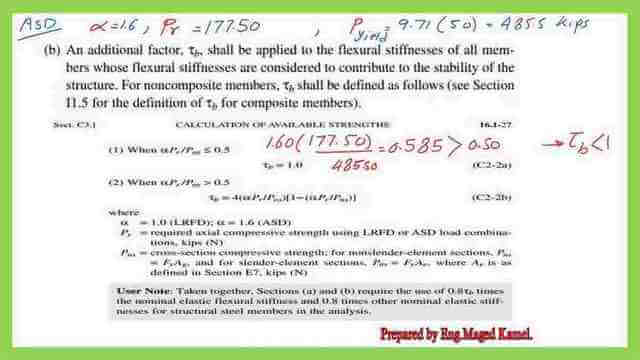
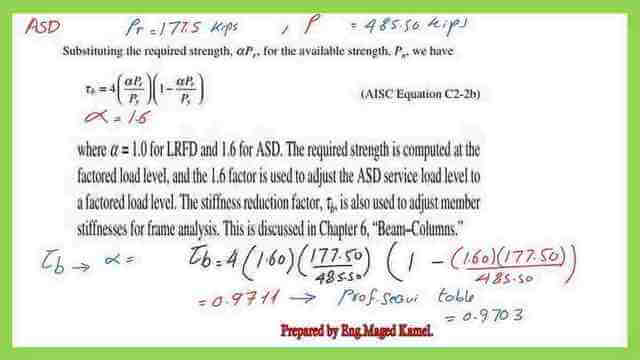
From Prof. Segui’s calculation τb=0.9703, which is extracted from table 4-13 as shown in the next slide image. how to use table, 4-13 is shown in full detail for the ASD design.
Use Table 4-13 to get τb -ASD design.
We have Pt/A=177.50/9.70=18.28, we move with this value from the horizontal direction and intersect with the column for Fy=50 ksi. The stiffness factor is equal to 0.9703.
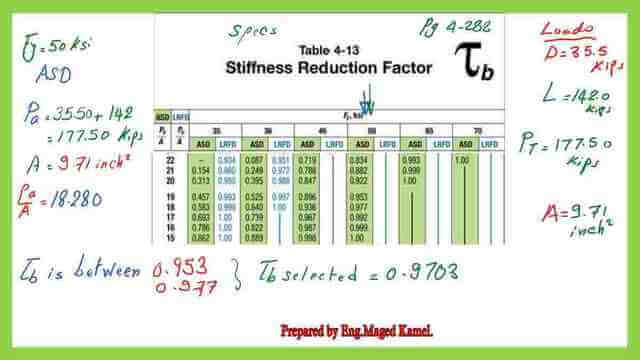
We need to adjust the k value, this is done by re-adjustment of GA, Gb, by multiplying by τb. The adjusted value of Ga=1.52*0.9703=1.47, while the adjusted value of Gb=1.36*0.9703=1.3432.28 for the Solved problem 4-14 part 2 for effective length factor.
The final Kx value is found to be equal to 1.43 while Ky=1.0. I hope this post will add something in the subject of compression steel members.
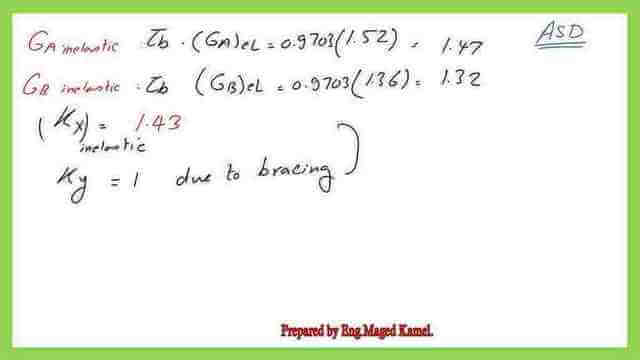
For the previous post please refer to Solved problem 4-14-effective length factor-Part 1
A very useful external link A very useful external link. A Beginner’s Guide to the Steel Construction Manual, 15th ed.
